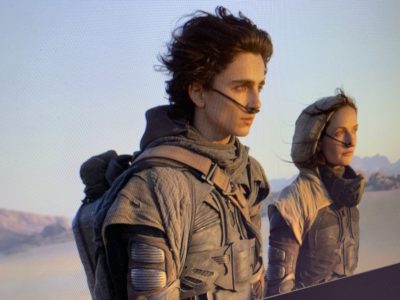“My planet, Arrakis, is so beautiful when the sun is low.”
The camera pans over the sprawling desert, and the sun’s orange haze tinges the sand as it sets behind a shimmering wall of heat. Flecks of gold — melange, also known as “spice” — catch in the dying light, blending with particles of windswept sand.

As full darkness sets in, soldiers of the Baron Vladimir Harkonnen — the feudal warlord in charge of the planet Arrakis — sweep the desert floor, decked out in costumes beyond George Lucas’ wildest dreams. The sand at their fleet explodes as desert tribesmen wearing specially modified suits rise out of the sandstorm like ghosts, and fighting ensues. Cue rockets, lasers and explosions.
Welcome to “Dune.”
Arguably the most grossing science fiction book of all time, “Dune” is the second film adaptation of Frank Herbert’s massive and wildly complex 1965 novel. The book — and its four appendices on the ecology and religion of the made-up world and the motives of people within it — follows the tale of Paul Atreides, the son of a royal duke in a dystopian future where noble houses branch out across the galaxy. Each noble rules over planetary fiefs and competes with one another for power.
The story begins with the Atreides family accepting the stewardship of the desert planet of Arrakis — a land previously controlled by their sworn enemies, where water is more valuable than gold and the key export is the melange, the geriatric drug that extends life and grants prescient abilities necessary to space travel.
Never mind that the first adaptation in 1984, directed by David Lynch, fell spectacularly on its face, or that Denis Villeneuve’s new film only covers the first half of the first book, or that the narrator of the opening scene, played by Zendaya, doesn’t even enter the narrative until the final 15 minutes of the movie: This is something to get excited about. “Dune” could be the next “Lord of the Rings.”
Then again, it could also flop.
The 1984 film failed partly because the challenges of the story itself lay outside the skillset of the movie’s director. Lynch’s gift for making the familiar bizarre, as seen in a film like “Blue Velvet,” is inappropriate for a narrative that demands the exact opposite.
Although set about 20,000 years in the future, Herbert’s world feels more hauntingly ancient than alien. It is governed by a feudal political system, and the desert people of Arrakis, the Fremen, follow a messianic religion and language that studiously borrows from Islam and Arabic.
Villeneuve, who directed “Arrival” and “Blade Runner 2049,” succeeds where Lynch could not in highlighting that “Dune” is as much an exploration of our past as a speculation on our future. In that spirit, the masterful soundtrack contributed by Hans Zimmer feels somewhat anachronistic — blending reverberating synthesizers with wailing vocals to produce an effect that can remind listeners of his work in both “Gladiator” and “Interstellar.”
To cut Lynch some slack, the new adaptation is, of course, aided by modern CGI. But with a budget of only $165 million — almost $100 million less than the new Bond movie — the film doesn’t feel excessive in its animation. Villeneuve uses it when it counts, giving interstellar spaceships, the invasion of Arrakis and the 400-meter-long sandworms — known as Shai-Hulud to the Fremen — their cinematic due, but for the most part, he lets the spectacular deserts of Abu Dhabi speak for themselves and focuses more on the drama.
And the drama is the real question here. For the first 20 minutes of the film, the story may seem nonsensical to anyone who has never picked up the book. A prophetic truthsayer arrives in a spaceship and holds a poisonous needle to Paul’s neck and forces him to put his hand in a box that contains … pain? When the test is done, she tells him that she now knows he is a human being.
There’s action enough later in the movie, including an awesome aerial combat scene where Jason Momoa pilots a futuristic helicopter out of a burning city, that rivals anything from the final season of “Game of Thrones.” Villeneuve does his best to dispatch with the necessary explanatory exposition early in the narrative so that the rest of the story can take control of itself and flow. But Herbert needed a serious volume of notations to make sense of the political, environmental and religious parable he was trying to tell. How well could all that be explained in a single film?
The biggest test for “Dune” is still to come, assuming officially it’s greenlighted for a sequel. Villeneuve is walking a fine line between fleshing out the rich, complex, philosophical drama that Herbert loyalists will believe is owed and producing a box office knockout for a wider audience that WarnerMedia will feel merits the sequel.
The production team is relying on an all-star cast — Timothée Chalamet, Zendaya, Stellan Skarsgård and Jason Momoa, among others — to rack up some revenue, but the script might leave fans of individual actors dissatisfied. Herbert’s characters are stiff and formal. Villeneuve has loosened up the dialogue a bit, but audiences aren’t going to get any “classic” performances from Oscar Isaac or Josh Brolin. The love interest between Chalamet’s Paul Atreides and Zendaya’s Chani that is shipped so heavily in the trailers doesn’t materialize in the would-be saga’s opening act. The two characters exchange only enough lines of dialogue that can be counted on two hands — maybe even just one.
It will be interesting to see how “Dune” is received after opening weekend, once the book snobs have gotten their fill and the movie is open to the general public’s judgment.

























































































































